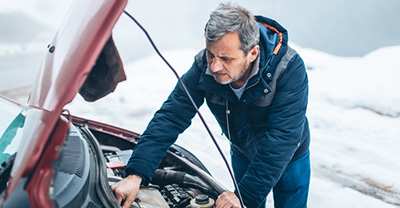When winter rolls in and temperatures drop, car batteries often become a common point of frustration. You might be asking yourself:
“Does cold weather kill batteries?”
The answer is: Yes, cold weather can significantly weaken—or even kill—a battery.
But it’s not always instant or permanent. Let’s explore how cold temperatures affect battery performance, why it happens, and what you can do to avoid getting stuck with a dead battery on a freezing morning.
Why Cold Weather Is Hard on Batteries
1. Reduced Chemical Reaction
Car batteries work by producing electricity through a chemical reaction inside the battery. In cold weather, that chemical process slows down, meaning:
- Lower voltage output
- Slower cranking speed
- Harder engine starts
At 32°F (0°C), a typical battery can lose about 20% of its power.
At 0°F (-18°C), it can lose up to 60%.
2. Increased Power Demand
While the battery’s power output drops in the cold, your vehicle is demanding more power to start:
- Cold engines need more effort to turn over
- Thicker engine oil increases resistance
- You’re using more electrical systems (heater, defroster, lights)
This double hit—weakened battery + increased demand—is what causes so many cold-weather battery failures.
Does Cold Actually “Kill” the Battery?
Cold doesn’t destroy the battery’s internal structure, but it can:
- Drain its charge quickly
- Reveal existing problems like weak cells or poor connections
- Make a borderline battery completely fail to start your car
If a battery was already old or partially charged, cold weather may push it past the point of recovery—which feels a lot like it’s been “killed.”
Signs Your Battery May Not Survive the Cold
- Slow engine cranking
- Clicking sound when you turn the key
- Dim headlights or interior lights
- Check battery light on the dashboard
- Battery is older than 3–5 years
Tips to Prevent Battery Problems in Cold Weather
1. Have the Battery Tested
Most auto parts stores will test your battery for free. Get it checked before the temperatures drop.
2. Keep the Battery Fully Charged
A fully charged battery handles cold much better than one that’s low. Take longer drives or use a battery maintainer if the car sits for extended periods.
3. Park Indoors When Possible
A garage can keep your vehicle and battery noticeably warmer than the outside air.
4. Clean the Battery Terminals
Corrosion or loose connections can reduce power flow. Clean terminals and tighten cables to ensure a strong connection.
5. Consider a Battery Blanket or Heater
In extremely cold climates, battery warmers can help maintain function overnight.
FAQs
Can a new battery die in cold weather?
Yes. If a new battery is not fully charged or installed incorrectly, it can fail in cold conditions—though it’s less likely than an old one.
Will jump-starting a frozen battery work?
If the battery is frozen solid, do not attempt to jump-start it. A frozen battery can explode. Let it thaw in a warmer place first.
Should I let my car idle to warm up the battery?
Modern engines don’t need long warm-ups. However, driving your car regularly and for at least 15–20 minutes helps keep the battery charged.
Final Thoughts
Yes, cold weather can kill batteries—especially if they’re already weak or near the end of their life. The combination of reduced battery power and higher engine demands makes winter the most common season for battery failure.
The good news? It’s also one of the easiest issues to prevent. By checking your battery ahead of time, keeping it charged, and taking a few smart precautions, you can avoid the dreaded click-click of a dead battery on a frosty morning.








